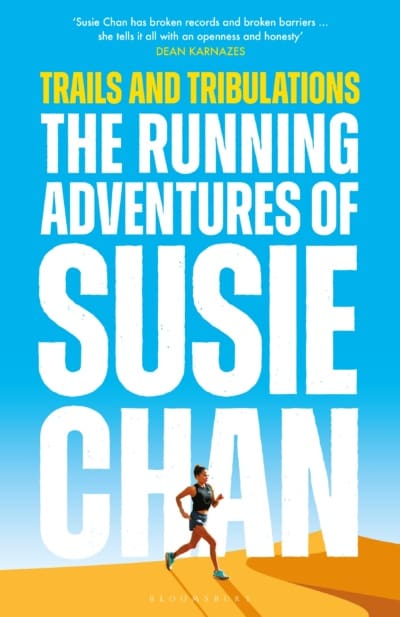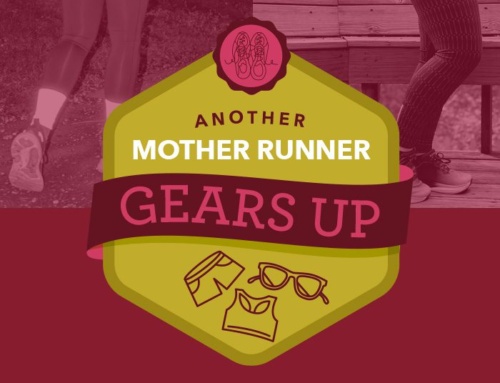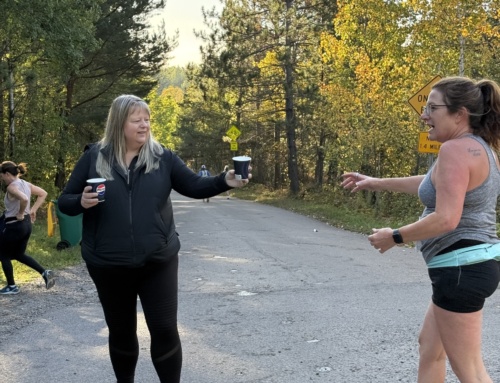Peloton instructor and ultrarunner Susie Chan shares an excerpt from her book Trials and Tribulations: The Running Adventures of Susie Chan. Want more of Susie? Head over to the Many Happy Miles podcast today and listen to our full interview.
I am falling. This one is a big one: sliding downhill with my arms flailing, trying to find anything to grab to stop the slide. I get hold of a plant, which immediately crumbles in my grasp. I try another branch, which stabs me in the palms with thorns. I continue to slide.
What if I never stop sliding and am lost forever?
A third attempt on a small stump gives me enough to halt my undignified slide. Lying here winded and caked in mud, I am sweating profusely in the humidity. I am bleeding from scratches, and within seconds I can also feel an army of ants crawling, biting and sticking to my clammy skin. Under my clothes, they itch and nip.
I hate it here. A tiny part of me wants, out of sheer tiredness, just to keep on sliding. I simply don’t care anymore. Running is stupid. This is it, my inner voice says. This is what it finally feels like to reach your limit. You’re done.
This is new. In the past I have experienced everything during races, from fury to exhaustion to questioning my life choices, but I have never felt like this. This is despair. Utter despair. I have nothing left, no desire to continue, to run, or even to stand up.
I have spent the best part of an hour trying to work my way upwards through the thick vegetation. At what point does a bush become a tree? I have never seen plants so big, or leaves that are metres wide and tall. There is growth everywhere I look – all around me, covering the floor of the jungle, as far up as the eye can see, blocking out a lot of the light. Plants are wrapped around other plants. And everywhere is alive. The prospect of giant spiders appearing terrifies me.
In the jungle you get the distinct impression that a thousand bug eyes are on you at any given moment. Looking out from under logs or from a great height. The ones that want to bite you are terrifying to an arachnophobe like myself. I try not to think about the biting spiders.
In the slippery mud, I can get virtually no purchase underfoot. I am climbing, climbing, and climbing up what feels like the sheer savage face of the rainforest. This is more of a fight with nature than running. This is vegetation with meat on its bones.
Physically I am shattered; this is beyond tedious and just staying focused on moving forward is itself a mental battle. I am making painfully slow progress and now, finally, with the top in sight, I lose my footing.
I am back where I started, having fallen all the way back down. Weighed down by my bulky rucksack, I lie there like an upturned beetle contemplating how on earth I, a normal person, have ended up here. It was not that long ago I was sitting at a desk making a mental note to buy a tin of Whiskas for Sinbad, my cat, on the way home. I am now thousands of miles from civilisation, from my small but cosy house in Surrey.
I look up into the canopy of trees above me. I can just make out small patches of sky through the dark green ceiling, layer upon layer of branches and foliage. Everything is damp – my clothes, the air, my spirits. Every breath of air smells like earthy mud and wet leaves. I can taste salt in my mouth and feel my skin itching from hundreds of tiny painful cuts. Somewhere deep in the Amazon rainforest, many miles south of Lima, Peru, I wail: Ahhhhhhhhhhhhhhhhhhhhh! A proper self-pitying wail from the bottom of my stomach. No one hears.
And this is the fourth day – the fourth day of this utter, total bullshit.
I am about to be taught a valuable and extremely painful lesson. A lesson so severe I will emerge vowing to never, ever, ever set foot back in a jungle.
______
Wind back several months, and my partner Shaun and I were channel-hopping when we stumbled across a documentary. Suddenly on the screen was someone running in the jungle, wearing a race bib. A chap called Richard Parks, taking part in a race called Jungle Ultra. It didn’t look too bad. Sure, the terrain looked muddy in parts, and there were river crossings, but the whole episode reeked of adventure.
At this point, I should admit that I’m terribly impressionable. TV adverts work brilliantly on my simple mind: all I need to see is a pizza box and I want pizza. Such impressionability has been a bit of a hindrance overall, to be honest.
Right then, on TV, the race looked relatively manageable. Only in hindsight did I conclude that the camera crews could not possibly have accessed huge parts of the course, or seen the misery – as well as the true wonder – that the jungle has to offer.
The format for this race is similar to the Marathon des Sables: multistage racing. Five days of running with a finish line edging closer to the Amazon Basin and the relative comfort of a small town, Pilcopata. It takes place in June, neither the wettest nor the hottest time of year for a jungle. In between the starting point and the end is 250 kilometres (155 miles) of the odd dirt road, endless foliage, streams and rivers, and a lot of elevation. We would start off around 14,000 feet up – the typical height for jumping from a plane to skydive is 10,000 feet. Starting at altitude is unusual, meaning that the race is a net downhill run!
The problem with looking at race statistics as a guide to the race, though, is the element which you cannot define with numbers – and that is the terrain. I was to discover that running just one mile can be very different in a jungle.
Another unusual feature of this race is the different daily mileages. Not only do the days get longer as the week progresses, they get more difficult. You start at high altitude, in summer, where it is warm. The weather is calm, but as you move lower and through the course, conditions get hotter and more humid, more ‘jungly’. This coupled with fatigue and hunger, which both increase day upon day.
The last day is the longest stage. Even at the time I recognised this was not ideal, but as with most races you can only go on the facts presented to you – and on paper it seemed manageable. The format was familiar, though it was somewhere new, a new environment to run in. And it looked great in the pictures!
There was also a new race director, the enterprising Kris King. We chatted before the race and he made it sound more like an expedition, like nothing I had ever experienced.
To be frank, the prospect of giant spiders was seriously putting me off. I generally swerve sheds, outbuildings, sitting on logs in the woods and the like – any situation, in fact, which could increase the chances of me meeting a spider. I hate them. Being from the home counties in the UK, I didn’t really have too much concept of jungle animals, either. But this was the jungle, the real deal, full of predators and poisonous things.
However, Shaun was very keen I did not dwell on the risks or any worst-case scenarios. And it’s true I’m of the mind that such thinking is not really very helpful in the world of ultrarunning anyway. So, feeling a little bit responsible for putting him through the Marathon des Sables, I agreed. It’s only running, right?
Excerpted from Trails and Tribulations: The Running Adventures of Susie Chan by Susie Chan, run with permission of the author, courtesy of Bloomsbury Sport, an imprint of Bloomsbury Publishing Plc.© Susie Chan, 2024







Leave A Comment
You must be logged in to post a comment.